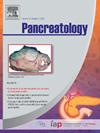新发高血糖患者胰腺癌的预测:改良的ENDPAC模型
IF 2.8
2区 医学
Q2 GASTROENTEROLOGY & HEPATOLOGY
引用次数: 0
摘要
背景/目的:丰富胰腺癌新发糖尿病(ENDPAC)模型主要依赖于空腹血糖值。医疗系统越来越多地转向使用糖化血红蛋白(HbA1c)测量。我们利用新发高血糖患者修改了ENDPAC模型:确定了 2011-2018 年 HbA1c 结果≥6.2-6.5%的 50-84 岁患者的四个队列。组成了一个联合队列。扩大资格标准后,又形成了四个个体队列和一个联合队列。主要结果是首次 HbA1c 检测升高后 3 年内诊断出胰腺癌。通过AUC、灵敏度、阳性预测值、检出病例数和筛查患者总数评估了改良ENDPAC模型的性能:个体队列和合并队列中分别有 39,001-79,060 名和 69,334-92,818 名患者(平均年龄 63.5-65.0 岁)。三年 PC 发病率为 0.47%-0.54%。单个队列的 AUC 值在 0.75-0.77 之间,合并队列的 AUC 值在 0.75 之间。将四个单个队列合并后,可识别出更多的 PC 病例(当风险评分为 5 分以上时,合并队列可识别出 149 例 PC 病例,单个队列可识别出 113-116 例 PC 病例)。非白人的性能指标受到影响。当风险评分为 5 分以上时,亚裔和太平洋岛民的敏感性低于其他种族和族裔群体(29% 对 50-60%):结论:修改后的ENDPAC模型针对的人群更广,因此能识别出更多的癌症筛查高危患者。当该模型应用于非白人人群时,需要考虑其不同的性能。本文章由计算机程序翻译,如有差异,请以英文原文为准。
Prediction of pancreatic cancer in patients with new onset hyperglycemia: A modified ENDPAC model
Background/Objectives
The Enriching New-Onset Diabetes for Pancreatic Cancer (ENDPAC) model relies primarily on fasting glucose values. Health systems have increasingly shifted practice towards use of glycated hemoglobin (HbA1c) measurement. We modified the ENDPAC model using patients with new onset hyperglycemia.
Methods
Four cohorts of patients 50–84 years of age with HbA1c results ≥6.2–6.5 % in 2011–2018 were identified. A combine cohort was formed. A widened eligibility criterion was applied to form additional four individual cohorts and one combined cohort. The primary outcome was the diagnosis of pancreatic cancer within 3 years after the first elevated HbA1c testing. The performance of the modified ENDPAC model was evaluated by AUC, sensitivity, positive predictive value, cases detected, and total number of patients screened.
Results
The individual and combined cohorts consisted of 39,001–79,060 and 69,334–92,818 patients, respectively (mean age 63.5–65.0 years). The three-year PC incidence rates were 0.47%–0.54 %. The AUC measures were in the range of 0.75–0.77 for the individual cohorts and 0.75 for the combined cohorts. When the four individual cohorts were combined, more PC cases can be identified (149 by the combined vs. 113–116 by individual cohorts when risk score was 5+). Performance measures were compromised in nonwhites. Asian and Pacific islanders had lower sensitivity compared to other racial and ethnic groups (29 % vs. 50–60 %) when risk score was 5+.
Conclusions
The modified ENDPAC model targets a broader population and thus identifies more high-risk patients for cancer screening. The differential performance needs to be considered when the model is applied to non-white population.
求助全文
通过发布文献求助,成功后即可免费获取论文全文。
去求助
来源期刊

Pancreatology
医学-胃肠肝病学
CiteScore
7.20
自引率
5.60%
发文量
194
审稿时长
44 days
期刊介绍:
Pancreatology is the official journal of the International Association of Pancreatology (IAP), the European Pancreatic Club (EPC) and several national societies and study groups around the world. Dedicated to the understanding and treatment of exocrine as well as endocrine pancreatic disease, this multidisciplinary periodical publishes original basic, translational and clinical pancreatic research from a range of fields including gastroenterology, oncology, surgery, pharmacology, cellular and molecular biology as well as endocrinology, immunology and epidemiology. Readers can expect to gain new insights into pancreatic physiology and into the pathogenesis, diagnosis, therapeutic approaches and prognosis of pancreatic diseases. The journal features original articles, case reports, consensus guidelines and topical, cutting edge reviews, thus representing a source of valuable, novel information for clinical and basic researchers alike.
 求助内容:
求助内容: 应助结果提醒方式:
应助结果提醒方式:


